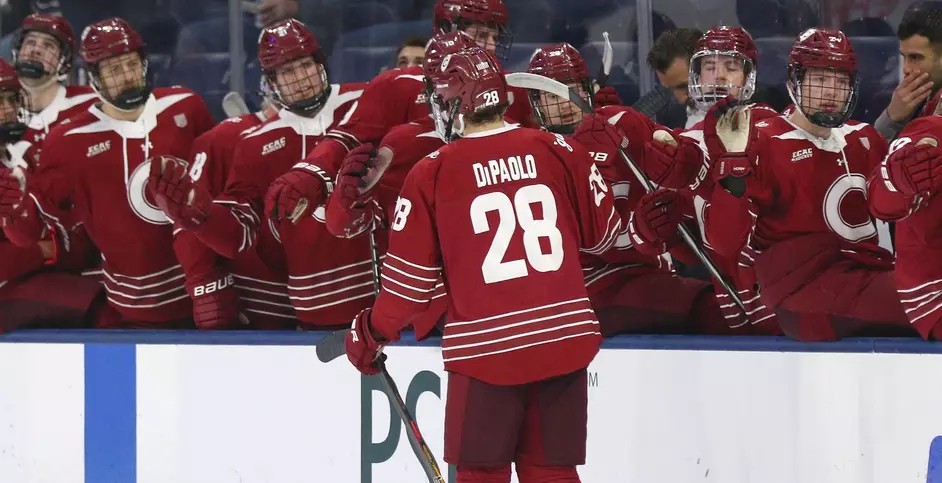
The 2023 NCAA tournament returned ECAC Hockey to one of its highest watermarks in college hockey’s storied history.
Alongside the Big Ten, the conference claimed four of the tournament’s 16 spots and represented a full quarter of the teams entered into the competition for the national championship. Two teams – Quinnipiac and Cornell – advanced out of the first round before the Bobcats advanced to the Frozen Four and national championship games with wins over Ohio State and Michigan.
A third win over the Big Ten cemented their first-ever national championship with a 3-2 overtime victory, but the final four field that included Boston University was a 2-1 loss away from pairing the Big Ten against the Big Red and a second team from the ECAC’s 12-team conference.
Two years later, things are drastically different for the only league untouched by the realignment periods over the last decade. One month remains in college hockey’s regular season, but likelihood and probabilities are increasing that ECAC will become a one-bid league for the first time since 2004. One team sits inside the bubble as of this weekend, but the numbers forcing Quinnipiac closer to the No. 16 slot makes it tougher to predict which league team would earn its way to the national tournament.
With that in mind, this week seemed like a good time to reset the league’s current situation while looking ahead to the last remaining major matchups involving teams in and around the bubble:
The current situation
-No. 14 Quinnipiac is the highest-ranked ECAC team in the Pairwise Rankings. While not an official indicator of the national tournament, the Bobcats are No. 15 in the USCHO.com poll.
-Cornell and Dartmouth are next-best in a tied spot at No. 20, while Clarkson and Colgate share the No. 26 spot in the Pairwise Rankings. No other ECAC team is inside the top 40.
The schedule
For purposes related to mathematics, all rankings moving forward are a team’s current seating in the Pairwise Rankings.
-Quinnipiac plays No. 9 Connecticut in this weekend’s CT Ice Tournament before facing either No. 30 Sacred Heart or No. 53 Yale in Saturday’s consolation/championship round. The Pioneers are the tournament’s host team, so playing UConn and Yale count as neutral site matchups.
-Dartmouth is at Colgate and Cornell, which means the Raiders and Big Red draw No. 42 Harvard on the other end of their weekend matchups with the Big Green.
-Clarkson has a home-and-home with travel partner St. Lawrence, which is tied with Canisius and Northern Michigan for the fourth-lowest spot in the Pairwise Rankings.
Immediate Implications
-Per PlayoffStatus.com, Quinnipiac currently holds a 51% chance of making the national tournament. The Bobcats are the top-ranked team in the league but have the most to gain this weekend because the matchup against ninth-ranked Connecticut is one of the last opportunities to gain a foothold against a better-ranked team. That said, a loss to UConn won’t necessarily damage their Pairwise hopes because the two teams behind Quinnipiac – Minnesota State and New Hampshire – are playing weekend series against No. 56 Ferris State and No. 32 Vermont. They likely won’t gain spots by winning, though No. 17 Wisconsin beating No. 10 Michigan wouldn’t hellp, either.
-A bigger issue for Quinnipiac is based on whichever team advances to play the Bobcats on Saturday. If Quinnipiac beats Connecticut, that’s obviously a good thing, but a game against No. 30 Sacred Heart carries significantly less risk than a game against Yale, a fellow ECAC team that lost 4-1 in a league game at Ingalls Rink earlier this year. They’ll play again in late February as part of the league schedule, but a win/loss situation against UConn/Sacred Heart likely leaves the Bobcats in the exact same situation as the weekend began. A win/win is obviously most preferable, and a loss/loss, it goes without saying, isn’t helpful at all. A loss to Yale at any point is the equivalent of UMass Lowell’s loss to Stonehill, which the Bobcats simply can’t absorb.
-While that’s happening, Dartmouth and Cornell very obviously face a pair of critical games towards their own Pairwise comparisons, with Friday’s rivalry game against Harvard looming largest. A loss to the Crimson, who played Boston College aggressively before splitting with RPI and Union, would drop the Big Red well out of the race before the Dartmouth game on Saturday. The Big Green, meanwhile, would also likely drop to the mid-20s with a loss to Colgate on Friday.
-The strangest scenario occurs if Harvard sweeps the weekend and Dartmouth beats Cornell after losing to Colgate. Under that scenario, the Big Red emerge as a bubble contender around the No. 20 spot while Dartmouth and Colgate fall to around the No. 25 spot ahead of other, undocumented results.
Future implications
I could sit here all night and write about the different implications of a future schedule, but it’s simply too difficult to predict at the current moment. Quinnipiac very clearly has the best chance of earning an at-large bid but plays six of its last nine games against teams ranked 40th or lower in the Pairwise Rankings. Dartmouth plays four games against Quinnipiac, Clarkson, Colgate and Colgate, which means the Big Green have plenty of games left to tread water while other teams around the No. 14 spot lose ground. Cornell plays Clarkson twice and Dartmouth once but was a preseason prediction for the national tournament.
-Clarkson still has that road game against Quinnipiac, along with a second home matchup against the Bobcats, before the postseason gets underway.
-All four teams are part of a tournament push for the top four spots and a possible first round bye, but Union and Harvard adding themselves into the mix complicates the idea around possibly gaining a first round bye or potentially playing more games with more games against higher-ranked opponents – a mathematical oddity that nobody wants to face except for maybe me, who enjoys chaos and can’t explain that properly.
-Like those oddities, it’s important to remember that Cornell and Colgate held the No. 15 and No. 16 spots in 2004 until Harvard won the league tournament. Both the Big Red and the Raiders were bounced from the tournament by league championships by Niagara and Holy Cross, but it ranked as the inverse of last year when St. Lawrence advanced to the league championship despite falling to No. 43 in the Pairwise Rankings. Had the Saints won, another three-bid league for ECAC would have matched Hockey East and eliminated UMass from the bubble.


